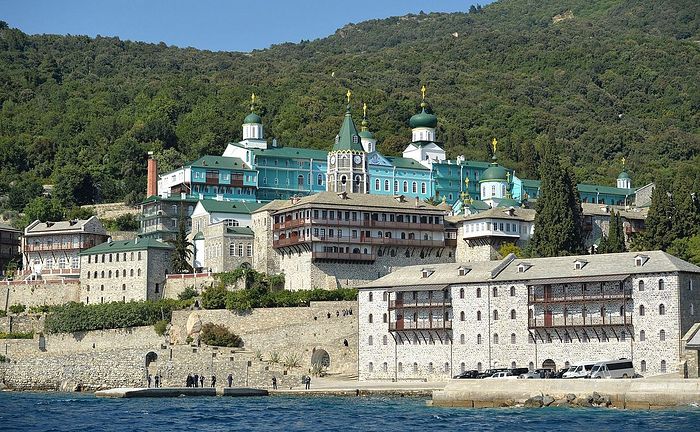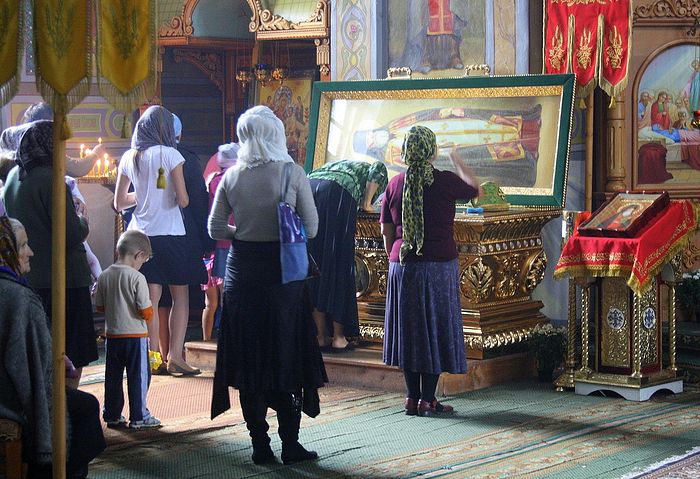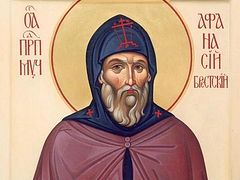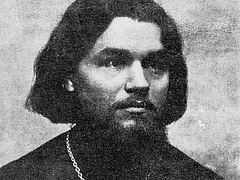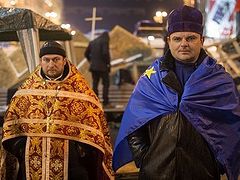 Aleksandr Kotenko. Sunrise over Mount Smotrich in the Carpathians. 2015. Photo: 01varvara.wordpress.com
Aleksandr Kotenko. Sunrise over Mount Smotrich in the Carpathians. 2015. Photo: 01varvara.wordpress.com
Introduction: Carpatho-Russia
Carpatho-Russia is situated in Eastern Europe, being a stretch of territory comprising the southwest facing slopes of the Carpathians. It is located in what is now northern and eastern Slovakia, south-eastern Poland and above all south-western Ukraine, in the region known as Transcarpathia. There are also Carpatho-Russians in Serbia and a few in northern Romania and Hungary. As well as this, there is a very large immigration, dating back to the late nineteenth century, mainly in the north-east of the United States.
Numbering nearly a million, the inhabitants of Carpatho-Russia are variously called “Ruthenians” and “Rusnaks”. In the eastern highlands of Carpatho-Russia there are “Hutsuls”, in the centre “Boikos” and in Poland, “Lemkos”. Most, however, live in the lowland foothills of the Carpathians. Generally, they call themselves “Carpatho-Russian” or “Rusin” (also spelled “Rusyn”). Their language is an East Slav language, close to, but distinct from, Russian and Ukrainian. The natural capital is Uzhgorod, since 1945 just inside the Ukrainian border. Other major towns are Mukachevo in the Ukraine and Presov in Slovakia.
Throughout its history, Carpatho-Russia has frequently been invaded, a victim of one great power or another, from Hungary and the Austro-Hungarian Empire to the Nazi Reich and the Soviet Union. For this reason it has various names, such as “Hungarian Russia” (from the Hungarian domination), “Ruthenia” (among the Latin-minded), “Transcarpathian Ukraine” (in Soviet and post-Soviet Ukraine), or “Subcarpathian Russia” (geographically and technically exact). Despite the attractions of the latter term, in this article we will mainly use the term Carpatho-Russia. In our context it seems the most applicable term for this island of Russian Orthodoxy outside Russia.
History and National Awakening
The south-west facing slopes of the Carpathians have been inhabited by the Slavs since at least the sixth century and are regarded as the cradle of Russia. However, in c. 896 the region was settled by the pagan Hungarians. They were tolerant of its Slav inhabitants, the Carpatho-Russians, who in the ninth century had already received Orthodox Christianity from Sts. Cyril and Methodius or their disciples—well before the Baptism of Rus in Kiev. However, the Hungarians were later to fall under the influence of the Germans, who were beginning to break away from the Church. Indeed, in the eleventh century, under their own Popes, the Germans began developing a new religion, which came to be known as Roman Catholicism. Unfortunately, they took the Hungarians with them.
Thus, after the 1054 schism, the Hungarians started to oppress the Carpatho-Russians, trying to baptizing them into the Roman Catholic schism. As in Western and Central Europe, the feudal system was introduced to suppress the peasant population. To this day several castles can be seen in Carpatho-Russia which witness to this oppression, which led to a resistance movement led by local heroes. Carpatho-Russia was then much tried by the Muslim/Tartar invasion of 1241, but Orthodoxy survived and even prospered. However, in 1646, Roman Catholicism attacked again, this time with the weapon of Uniatism. Sadly, during the late seventeenth and early eighteenth centuries, the impoverished and defenceless Carpatho-Russian Orthodox were gradually forced into accepting Uniatism in order to survive. The exception among them was the priest and writer Mikhail Orosvigovsky (Andrella) (1637-1710), who vigorously opposed the lie of Uniatism. The last Carpatho-Russian Bishop, Dositheus, was blinded and effectively died as a martyr in 1734 and the Hungarians did not allow new Orthodox clergy from then on.
Uniatism was later to be opposed by Uniats who themselves realized that the true interests of Carpatho-Russia were in an alliance with Orthodox Russia. In the nineteenth century, Uniat Rusins like the national poet, Alexander Dukhnovich (1803-65), or Ioann Rakovsky (1815-1885), Adolf Dobriansky (1817-1901) and Evgeny Fentsik (1844-1903) worked to revive the national conscience, allying themselves with the Slavophiles in Russia. Following this national awakening, the next step would come with the conversion of Carpatho-Russians to Orthodoxy, so finally shaking off the spiritual and national slavery of Uniatism.
The Story of the Return to Orthodoxy in Carpatho-Russia
One of the first to launch the return to Orthodoxy movement in Carpatho-Russia was Archimandrite Vladimir (Terletsky) (born 1808). At first a Uniat priest, he eventually became Orthodox in Kiev in 1872 after Hungarian persecution at home. In Kiev he wrote of the national awakening in Carpatho-Russia. A second personality was the Uniat priest Ioann Rakovsky (+1885), mentioned above, from the village of Iza near Khust (now in the Ukraine). Although he remained a Uniat until his death-bed, after him others actually joined the Orthodox Church, despite the fact that in the Austro-Hungarian Empire it was possible to join any religion—except Orthodoxy.
Thus, when in 1903 the villagers of Iza announced their intention to become Orthodox, their Golgotha began. Once the villagers had for the first time sung the Creed without the notorious filioque, Iza was flooded with Hungarian police. There were house searches and liturgical books and icons were confiscated. The police stayed in their village for several months, extorting food from the villagers, oppressing them and mocking the womenfolk. Eventually, the police began arrests and put 22 men on trial.
This trial, known as the “First Maramorosh-Sighet Trial” took place in 1904. The accusation was “Treason”, later changed to “Incitement against the Hungarian Nationality”. Three peasants, Joachim Vakarov, Vasily Lazar and Vasily Kamen were sentenced to fourteen months imprisonment and had to pay a huge fine with equally huge costs. Land, homes, cattle and domestic gear were auctioned off to pay these fines. The peasants were released from prison as paupers and their families were looked after by relatives with the help of the parish of Iza. However Joachim Vakarov and his friends were not daunted. Soon the Hungarians built a police station in the village, which was only three miles from another police garrison. Joachim Vakarov was seized and tortured to death. The peasants, priestless, buried him themselves, singing the funeral hymn.
Joachim's martyrdom only increased resistance. Several villages, Luchki, Tereblia and others, decided to return to Orthodoxy. The peasants searched for an Orthodox priest so they could be received into the Church, but at that time it was impossible for Russian priests to cross the border. It was only later that the great friend of Carpatho-Russia, the brilliant theologian and energetic restorer of Patristic Orthodoxy in Russia, Archbishop Antony (Khrapovitsky) (1863-1936), later Metropolitan of Kiev and First Hierarch of the Russian Orthodox Church Outside Russia, managed to obtain jurisdiction in the Carpathians.
Therefore the peasants approached the Serbian bishop in Budapest. The latter was afraid of the Hungarian authorities and refused to see the delegation. The peasants then went to the Serbian Patriarch in Karlovtsy, since his Church cared for all Orthodox in the Austro-Hungarian Empire. Although he received them, he too was fearful of Austro-Hungarian terror. The peasants replied that if he refused, then he would have to answer for this at the Last Judgement. The Patriarch decided to send a priest. When the Uniat bishop of the nearby town of Mukachevo heard this, he rushed to Vienna to denounce it, saying that if it were allowed, then his whole diocese would go over to Orthodoxy and he would be unemployed. His denunciation was heard favourably; this act will be on his conscience for all eternity.
Meanwhile, the peasants of Iza began holding their own services, until they were able to cross the border secretly to Romanian Bukovina, where a priest baptized their children. The peasants built a chapel in the village, but this was demolished by the Hungarian police, who forbade them to pray together. Nevertheless, other villages began to follow Iza in the great return to Orthodoxy. It was only in 1910 that Carpatho-Russia at last received a spiritual leader in the person of Hieromonk Alexis (Kabaliuk). It was in that year that he arrived in their village secretly, in a hay cart.
Fr. Alexis
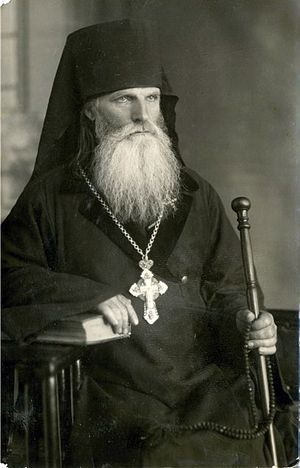 St. Alexis This confessor of Orthodoxy was born on 1 September 1875 in the Carpatho-Russian village of Yasinie, to the pious family of a wood-cutter, Ivan Kabaliuk and his very devout wife Hannah. The child, one of eight, was named after the holy Prince Alexander Nevsky. As a child he began parish school at the age of six and showed both piety and intelligence, reading all he could about Orthodoxy. He frequently visited the Orthodox monasteries in neighbouring Bukovina, and also the Uniat monastery of Kish-Baran. As a young man, he completed his military service only to return home and find his father on his death-bed. He then visited the Monastery of Biskad, now in Romania, to ask the clairvoyant Elder Arcadius whether he should marry or become a monk. The answer was monasticism.
St. Alexis This confessor of Orthodoxy was born on 1 September 1875 in the Carpatho-Russian village of Yasinie, to the pious family of a wood-cutter, Ivan Kabaliuk and his very devout wife Hannah. The child, one of eight, was named after the holy Prince Alexander Nevsky. As a child he began parish school at the age of six and showed both piety and intelligence, reading all he could about Orthodoxy. He frequently visited the Orthodox monasteries in neighbouring Bukovina, and also the Uniat monastery of Kish-Baran. As a young man, he completed his military service only to return home and find his father on his death-bed. He then visited the Monastery of Biskad, now in Romania, to ask the clairvoyant Elder Arcadius whether he should marry or become a monk. The answer was monasticism.
Since this sensitive soul could not accept the lie of Uniatism, in 1905 and 1906 Alexander visited the Lavras in Kiev and Pochaiev, where he met both the elderly Metropolitan of Kiev, Flavian, and the dynamic Archbishop Antony (Khrapovitsky), who was to play a vital role in Fr. Alexis’ later life. In 1908 he decided to go on pilgrimage to Mt Athos and Jerusalem. He became Orthodox in July 1908 at the Russian monastery of St. Panteleimon on Mt Athos and then returned to Russia, with the gift of an icon of the Mother of God of the Akathist, which was to accompany him for the rest of his life. In early 1910 he became a monk at the Yablochino monastery (now in Poland), took the name Alexis and undertook theological studies. On 15 August 1910, again with the support of Archbishop Antony, he was ordained hieromonk, with the name of Alexis. From there he was invited to Iza. He celebrated secretly here, also in Mukachevo and elsewhere.
In his homeland Fr. Alexis’ first enemy, and that of Carpatho-Russian spiritual identity, was Uniatism. The Austro-Hungarian policy of divide and rule meant separating the inhabitants of the Russian borderlands (the meaning of the word “Ukraine”) from the Russian motherland. This meant the religious artifice of Uniatism, which would later lead to the invention of a separate nationalist identity through “ukrainianization”. This weapon was especially used in the west of Little Russia (now the Ukraine), known as Galicia, which had long been under Polish influence. However, the lie was given to this Austro-Hungarian invention by the Carpatho-Russian Orthodox. Their own name for themselves, “Rusiny”, clearly showed that they were not some entirely different nationality and their whole history was in fact part of Russian Orthodoxy. They are not “Carpatho-Ukrainians”, but Carpatho-Russians This explains why the Austro-Hungarians were so frightened of Rusin Orthodoxy and tried to suppress it.
However, nothing could stop Fr. Alexis, neither torture, nor persecution. His strong faith, zeal and desire to serve his people were such that he worked as a wood-turner, for he was unwilling to live off poor peasants. He went around all the villages that had returned to Orthodoxy, celebrating the sacraments, teaching and strengthening in the faith. In one day he baptized 200 children and gave communion to over 1,000 faithful. According to a Hungarian newspaper, in the area of Maramorosh around Iza over 14,000 people became Orthodox.
Within two years Fr. Alexis had set up 28 Orthodox communities in various villages. He searched for help everywhere, returning again to Athos and also meeting the Patriarchs of Constantinople and Serbia. The persecutions worsened and Fr. Alexis was arrested several times. The police surrounded churches, searched homes, confiscating prayer-books, icons, crosses and religious literature. Huge fines were imposed on the peasants, the area was flooded with police and chapels were closed. Those who had become Orthodox were imprisoned. In reply, even more villages became Orthodox.
Fr. Alexis was hunted by the Hungarian Catholic authorities like a wild animal. In mid-1912 he was forced to leave first for Yablochino, then in the spring of 1913 for Russia, finally for America, where there was a large Carpatho-Russian colony. There, together with Fr. Alexander Khotovitsky, he continued his missionary exploits and hundreds of thousands of Carpatho-Russians returned to the Orthodoxy of their forebears. From here Fr. Alexis corresponded unceasingly with his flock and the Austro-Hungarians began arresting anyone with a letter bearing an American stamp. Several hundred were imprisoned, including all of Fr. Alexis' relatives.
Other Holy Confessors
The police resorted to torture. Orthodox were hung up on trees so that their feet did not touch the ground. In this way their noses, mouths and ears began to bleed. If the tortured began to lose consciousness, the police threw water over them so that the torment would continue. One woman from the village of Lezhie died as a result of this torture. Many underwent “the tree of torment”, but they did not renounce Orthodoxy. Others fled to the mountains and the forests.
In this way eleven girls, instructed by Fr. Alexis' sister, Vasilisa, became nuns secretly. They went off to the mountains, built a house in the forest and lived the monastic life there. The police found out about this and hunted them down. They forced them to strip, made them stand in their undergarments in icy water for two hours and then threw them into prison. Their names were: Maria Vakarova, Pelagia Smolik, Anna Vakarova, Maria Madiar, Pelagia Tust, Pelagia Shcherban, Paraskeva Shcherban, Juliana Azay, Maria Prokun, Maria Dovganich, Anna Kamen. In 1910, the Orthodox, priestless, turned to Russia for help. Candidates for ordination were sent to the monastery in Yablochino. Among them were Vasily Kamen and Vasily Vakarov. They were taken with love into the monastery. Meanwhile, the people of Iza gathered to pray at the home of a villager, Maxim Prokop. In 1913 his niece, Juliana Prokop, suffered for Christ, becoming a holy confessor. No more than a young girl, in 1913 she set up in her village what was in fact a convent.
On 23 July that year another Maramorosh-Sighet trial began. In this the prosecutor charged “Alexander” Kabaliuk, aged 36, and another 94 individuals, including the priests Gregory Gritsak and Nicholas Sabov and other peasants from Iza. Fr. Alexis voluntarily returned from his few months in the USA for the trial, in order to suffer together with his flock. With others they were charged with receiving help from Orthodox Russia and Mt Athos to convert Uniats to Orthodoxy. This was seen as treason by the Austro-Hungarians.
At this trial Fr. Alexis defended them, saying that they had no political axe to grind, their sole interest was the Orthodox Faith and that if they had to suffer for this holy cause, then so be it. The trial lasted for two months. Finally, on 3 March 1914 Fr. Alexis was sentenced to four and a half years' imprisonment and fined. The others received between three years and six months. On hearing the sentence, the Russian Emperor, Nicholas II, awarded Fr. Alexis a golden pectoral cross for his confession of the Faith and services were celebrated in the churches of Russia glorifying his feat.
During the trial the police burst into Iza and captured Juliana Prokop and her monastic sisters. Taken to the police station, they were tortured and the police tried to persuade them to renounce Orthodoxy. Then, in the frost, the girls were showered with water and forced into the street. Here they were stripped and beaten mercilessly. Barefoot and bare-breasted, they were paraded around the village in the hope they would renounce the Orthodox Faith. The streets remained empty and the villagers shocked, though helpless. The Uniat priest, who had called in the police, invited Juliana and craftily tried to persuade her to renounce the Faith. She remained firm, even though the tortures continued for another three months. Not a single sister gave up the Faith.
In early 1914 three priests arrived from Russia, Fr. Amphilochius (Vasily Kamen), Fr. Matthew (Vasily Vakarov) and Fr. Seraphim (later killed in the war). They were arrested immediately and sent to the nearby local centre of Khust. The first two were placed under house arrest and Fr. Seraphim was sent to the army. When the First War began, Fr. Amphilochius and forty peasants were arrested. He was sentenced to four years imprisonment. They also arrested Juliana and her sisters in Christ and they too were sent to Khust. They were freed only when Russian troops entered the town. After the Russian retreat, the sisters remained faithful and would meet together at night to pray. For spiritual guidance they went to Fr. Amphilochius, by then in prison in Kosice (now in Slovakia).
In 1917 all the sisters were again placed under house arrest, but this time they had to go to the police station for interrogation three times a day. In 1918 they beat Juliana almost to death. Her body was covered with wounds, her nose broken, her head badly bruised. The beatings were accompanied by words to persuade her to renounce Orthodoxy and the monastic life. But they failed. Disfigured and covered in blood Juliana was taken to the basement and covered in sand. Nobody was allowed to see her. On the fourth day Juliana came to. The police had not expected her to survive. She was taken to her father and a doctor called. However, she refused medical help and was healed miraculously. In 1924 Juliana the Confessor was tonsured with the name of Paraskeva and became Abbess of the Convent at Maramorosh. On her repose she was buried in the Monastery of St. Nicholas in Mukachevo.
Confessing the Faith Between the Wars
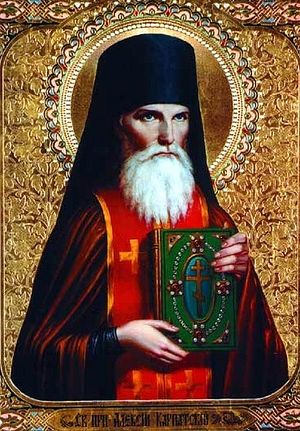 St. Alexis, Apostle of Carpatho-Russia After the First World War and the collapse of the prison of the peoples, the Austro-Hungarian Empire, Carpatho-Russia found itself in the new state of Czechoslovakia. Although the atrocities of the Austro-Hungarians had now stopped, unfortunately, the Saint Germain en Laye agreement of 1919 which had given rise to the new state, was not truly implemented. As a result, Carpatho-Russia did not receive autonomy within Czechoslovakia and attempts to Uniatize and ukrainianize continued. However those who tried this would now have to reckon with a free Fr. Alexis.
St. Alexis, Apostle of Carpatho-Russia After the First World War and the collapse of the prison of the peoples, the Austro-Hungarian Empire, Carpatho-Russia found itself in the new state of Czechoslovakia. Although the atrocities of the Austro-Hungarians had now stopped, unfortunately, the Saint Germain en Laye agreement of 1919 which had given rise to the new state, was not truly implemented. As a result, Carpatho-Russia did not receive autonomy within Czechoslovakia and attempts to Uniatize and ukrainianize continued. However those who tried this would now have to reckon with a free Fr. Alexis.
At the end of the First World War Fr. Alexis had been imprisoned and bayoneted for his Faith by the Austrians. In autumn 1919 he was cared for in hospital in Kiev and visited by Metropolitan Antony, his great admirer. The latter called Fr. Alexis “a hero” and even more prophetically, “a confessor and martyr for the Truth of Christ”. The story of this is related in Volume IV of the Metropolitan's Biography1. Returning from imprisonment and hospital, Fr. Alexis lived in the Monastery of St. Nicholas, which he had founded in Iza, next to the church in which Fr. Ioann Rakovsky had served. Here in 1921 he became Abbot. By then the villages around Iza, Bystry, Gorinchevo, Uybarovo, Lipcha, Tereblia and Koshelevo had all come over to Orthodoxy. Thanks to the work initiated by Fr. Alexis, over a relatively short period of time more than a thousand Rusin parishes would eventually return to Orthodoxy. Fr. Alexis was aided in his missionary work by two of Adolph Dobriansky's grandsons, Alexis Gerovsky (1883-1972) and George Gerovsky (1886-1959).
On the Feast of the Transfiguration 1921, Fr. Alexis opened the Council of the Carpatho-Russian Orthodox Church. There were over 400 delegates from all the Orthodox villages of the region. The delegates accepted a constitution and the official name “The Carpatho-Russian Eastern Orthodox Church”. The Conference decided to remain within the Serbian Church, then under the excellent Bishop Dositheus, as before, especially as so many of the Serbian representatives had studied in Russia and the Russian Orthodox Church Outside Russia was based in Serbia.
The head of the exiled Russian Church in Serbia was Fr. Alexis' old patron, Metropolitan Antony (Khrapovitsky), who continued to help the Carpatho-Russians. He sent the famed missionary, Archimandrite Vitaly (Maximenko), to the area around Presov (now in Slovakia). Before the Revolution Fr. Vitaly had headed the typography at the Pochaev Laura. Now, to the north of Presov, he founded the Monastery of St. Job, brought monks from Valaam and started to publish a newspaper “Orthodox Carpatho-Russia”. This later became the official journal of the Russian Orthodox Church Outside Russia.
The Carpatho-Russians also received help from the seminary in Bitol in Serbia, especially from its most distinguished representatives Fr. (later St.) John (Maximovich) and Fr. (later St.) Justin (Popovich). The latter served for some time as a missionary around Presov. Altogether over 11,000 White Russians settled in Carpatho-Russia, among them Archimandrite Vasily Pronin (1911-1997), who later took the schema. As well as being an Elder, the latter was also an extraordinary linguist (he spoke fourteen languages) and a geologist, writing a still unpublished “History of Carpatho-Russian Orthodoxy from the Beginning until our Days”.2
Nevertheless, Orthodoxy in the Carpathians was to undergo yet another temptation. This time it was not from outside, but from inside the Church, the temptation of schism. At that time the new Patriarch of Constantinople, Meletios Metaksakis, an ecumenist and a modernist, began to support the Soviet renovationist schismatics and fiercely persecuted the monks of Valaam for keeping the Orthodox calendar and resisting renovationism. To counter the Orthodox Serbs, this Patriarch appointed a Bishop Sabbatius to Carpatho-Russia, with the support of the pro-Catholic Czechoslovak government. Once more Archimandrite Alexis, which he had become in 1925, stood guarding the canons. He supported the Czech Bishop (now St.) Gorazd under the Serbian Church and the Carpatho-Russian Church managed to fight off the claims of the modernists. Thanks to Archimandrite Alexis, who was Bishop in all but name, in 1931 the Mukachevo-Presov Diocese was established.
Church of the Annunciation
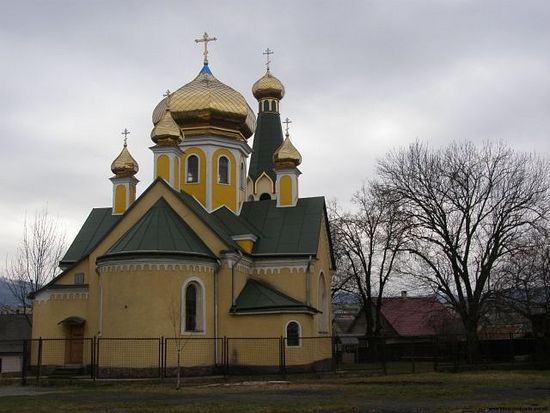 The Church of the Annunciation in Khust
The Church of the Annunciation in Khust
The Church of the Annunciation in Khust, built by Fr. Alexis and consecrated in 1928.
Despite immense difficulties, the Rusin Orthodox movement, led by Fr. Alexis, blossomed in the 1920s and 1930s. Thus, according to 1936 statistics, the Mukachevo-Presov diocese consisted of 127 churches, had 138 priests and 140,000 faithful. The Carpatho-Russians stood against artificial anti-Orthodox and pro-Catholic Ukrainian nationalism. Fr. Alexis was convinced that Carpatho-Russia should be united with a free Russia. Not only a strict ascetic and man of prayer, he was also a national leader and stood up for organizations like the Party of Native Orthodox of Subcarpathian Russia, the Russian People's Party for Reunion and the Orthodox Russian Bloc, which later struggled against the pro-Nazi regime of the Uniat Augustine Voloshin. He also set up the famous “Orthodox Committees”, which in the 1930s fought for the purity of the Faith, for Russia and against Ukrainian separatism. Thus, in 1937, 83% of the Carpatho-Russians were to vote in a referendum in favour of the Russian language, rejecting the so-called “Ukrainian” identity foisted on them.
After the Nazi invasion of Czechoslovakia in 1938, the mainly Galician Ukrainian nationalists received financial and political support from another Austrian—Hitler. Led by the Uniat Voloshin, the Ukrainian nationalists who supported Hitler, tried genocide against the Rusins, sending many to concentration camps in Svaliava and Rakhov. However, between 1939 and 1944 Carpatho-Russia was taken over by Hungary under Hitler's orders, but after liberation in 1944 by the Soviet Red Army, the Rusin Golgotha proved to be far from over.
Confessing the Faith under the Soviets
In 1944, Carpatho-Russia was liberated from Nazi oppression. In the face of the atheist scourge, once more it was Fr. Alexis who tried to oppose what was happening. On 18 November 1944 scholars, social leaders and 23 Orthodox priests, attended an Orthodox Conference in Mukachevo. The Conference, chaired by George Gerovsky, launched an appeal to Stalin, signed among others by Abbot Theophan Sabov, locum tenens of the Diocese of Mukachevo and Presov, and Archimandrite Alexis. They asked for an Autonomous Carpathian Republic to be formed for all Rusins—”sons of Russia”. Having lived in slavery to the Hungarians and Germans for centuries until 1919, they wished to be joined to Great Russia. As they rightly said, they had first heard the word “Ukraine” only during the Czechoslovak period, when Galician nationalists had come to make their propaganda around it.
However, despite the valiant efforts of Fr. Alexis, the atheist and anti-Russian Soviet Communist Party was to have no truck with their pleas and betrayed the Rusin Orthodox patriots. Ukrainian Communists, headed by Khrushchev, were with Stalin already organizing the transfer of Carpatho-Russia from Czechoslovakia to the Soviet Ukraine. At the same time, the Orthodox, previously in the jurisdiction of the very supportive Serbian Church, were transferred to the Moscow Patriarchate. At once, the Soviet authorities began to close down both the remaining Uniat churches and also Orthodox churches and monasteries. Their property was seized, just as had happened in Russia itself after 1917. Forced ukrainianization began in the cradle of Russia.
The Soviet persecution of Carpatho-Russia was perhaps the greatest tragedy of all in the life of Archimandrite Alexis, who took the schema on 22 November (new style) 1947. Seeing the cruelty and dishonesty of the atheists, on 2 December (new style) his good and generous heart stopped beating, he was aged 70. Many say that he was poisoned by the Secret Police. Fortunately, he did not live to see Carpatho-Russia incorporated into the Soviet Ukraine, the Rusins renamed Ukrainians and the repression that followed. Fr. Theophan Sabov, a firm Russophile who would probably have become the next Bishop of Mukachevo, disappeared and was probably martryred. Rusin patriots were exiled and sent to the GULag, forced ukrainianization took place with 500 Rusin schools closed. Rusins were sent to concentration camps just for speaking their language in public. The atheist Red Army soldiers who had arrived in 1944 had not represented at all the Holy Russia the Rusins had so long awaited.
Thus, the treacherous Bolsheviks tried to ukrainianize the population, using the same tool as the Austro-Hungarian Catholics and Nazi Ukrainians before them. The main persecutor was the notorious Khrushchev, who in 1954 gave away the Crimea to the Ukraine and later brought the world to the brink of nuclear annihilation, also declaring that by 1970 all the churches in Russia would be closed. The Soviet State was attacking the very cradle of the Russian people. “Transcarpathian Ukraine”, as they called Carpatho-Russia, was industrialized and the ecology damaged through militarization and deforestation. Many Rusins (“Transcarpathians”) were forced to the Ukraine to find work and alcoholism flourished in the centralized Soviet “lumpen-culture”. Only the Orthodox clergy remained as witnesses to Rusin national identity.
The Spiritual Victory of Carpatho-Russia
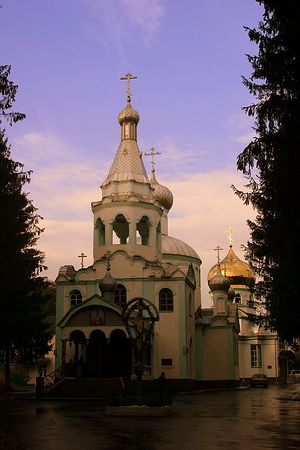 The Monastery of St. Nicholas in Iza Since the fall of the Soviet Union in 1991 and the independence of the Ukraine, various schismatic movements have spread there. However, Carpatho-Russia has remained faithful to Orthodoxy. Over 500 parishes and 20 monasteries there remain loyal to the Russian Orthodox Tradition and the Carpatho-Russians still seek autonomy from the Ukraine. Thus, in the spiritual centre of Carpatho-Russia, the Monastery of St. Nicholas in Iza, led by Archimandrite Stratonicus (Legach), keenly opposed and opposes the schismatic Ukrainian “Church”, headed by the defrocked Philaret Denisenko in Kiev, as did the Carpatho-Russian Elder, Schema-Archimandrite Vasily (Pronin).
The Monastery of St. Nicholas in Iza Since the fall of the Soviet Union in 1991 and the independence of the Ukraine, various schismatic movements have spread there. However, Carpatho-Russia has remained faithful to Orthodoxy. Over 500 parishes and 20 monasteries there remain loyal to the Russian Orthodox Tradition and the Carpatho-Russians still seek autonomy from the Ukraine. Thus, in the spiritual centre of Carpatho-Russia, the Monastery of St. Nicholas in Iza, led by Archimandrite Stratonicus (Legach), keenly opposed and opposes the schismatic Ukrainian “Church”, headed by the defrocked Philaret Denisenko in Kiev, as did the Carpatho-Russian Elder, Schema-Archimandrite Vasily (Pronin).
They have been followed in the next generation by a new spiritual and national leader, Archpriest Dimitry Sidor (1955 –), architect and rector of the new Orthodox Cathedral in Uzhgorod, Chairman of the patriotic Orthodox Rusin “Society of Sts. Cyril and Methodius”, publicist and translator of the Gospel into Carpatho-Russian. He has been supported by Abbot Gavriil (1973), a historian of the Orthodox Church in Carpatho-Russia. Both have promoted the idea of a feast-day for the saints of Carpatho-Russia and established a list of local saints, which we will shortly be translating on this site.
In 1998 the Serbian Orthodox Church canonized Bishop Dositheus who did so much for Carpatho-Russian Orthodoxy before the Second World War. Then, in February 1999, at St. Nicholas Monastery in Iza, Bishop Agapit of Khust (now of Mukachevo) and Archimandrite Stratonicus uncovered the relics of Schema-Archimandrite Alexis (Kabaliuk). They found them to be almost completely incorrupt. The body, skin and monastic mantle were all intact and only the feet and the wrists had perished in the extremely damp earth. From the grave was taken the Iviron icon of the Mother of God, which Fr. Alexis had brought with him from Mt Athos. Its colours had not even faded. This was an extremely important event in the spiritual life of Carpatho-Russia. Its spiritual father was intact, as was its spiritual ideal.
His canonization took place at the Monastery of St. Nicholas in Iza on 21 October 2001, under His Beatitude Metropolitan Vladimir of Kiev and all the Ukraine with many bishops and some twenty thousand faithful. His title is “Apostle of Carpatho-Russia”. The event had an extraordinary significance, for it marks a turning-point in the life of Carpatho-Russia. It brings the whole region to life not as some schismatic and nationalistic Galician Uniat area of the Western Ukraine, but as an Orthodox centre. The glorification of the holy confessor Alexis shows him to be a national leader of the Rusin people, a true “Apostle”, and shows that they are true children of Russian Orthodoxy, faithful to the Tradition and their own historic destiny.
St. Alexis, Apostle of Carpatho-Russia
The great idea of unity with Mother-Russia is alive in Carpatho-Russia. This unique island of the Russian Orthodox Tradition in Europe, which has survived through the feats of blood and prayer cannot be overlooked. After the catastrophes of Hungarian Catholicism and Tartar Islam, Austro-Hungarian Uniatism and Czechoslovak-Constantinopolitan Modernism, Germano-Hungarian Fascism and Soviet-Ukrainian Communism, a window of opportunity has opened for the Rusin people to find their path. Their spiritual leader on that path will always be their Apostle, the twentieth-century saint, Schema-Archimandrite Alexis, and the holy confessors who struggled and suffered with him. This canonization surely marks the beginning of the glorification of the host of Carpatho-Russian saints and has broken through the wall of silence about Carpatho-Russia.
Conclusion: The Spiritual Significance of Carpatho-Russian Orthodoxy
On a broader level, today there is the question of the general destiny of Russian Orthodoxy Outside Russia. Today islands of Russian Orthodoxy live all over the world and even in different languages. True to the Tradition and the Orthodox calendar, they are threatened from all sides, just as Carpatho-Russian Orthodoxy has been threatened throughout the ages. They are menaced by Catholicism and Islamism, Uniatism and Modernism, Fascism and Communism, every variety of human invention, every “ism”. Nevertheless, these islands of the Russian Orthodox Tradition survive in the towns and cities of Western Europe, North and South America, Australasia and in the Holy Land. Fighting off the spiritual cancer of Renovationism, they are witnesses to the spiritual feat of faithfulness. If Orthodoxy can survive outside Russia, as it has done for a thousand years in Carpatho-Russia, then the rest of us should take heart from their example and do the same.
Holy Father Alexis and All the Confessors of Carpatho-Russia, Pray to God for us!


